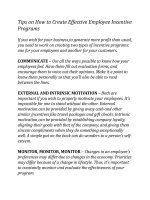How to connect sentences
Bạn đang xem bản rút gọn của tài liệu. Xem và tải ngay bản đầy đủ của tài liệu tại đây (8.32 KB, 1 trang )
How to connect sentences?
One of the easiest ways of changing sentence structures is to connect them using a
coordinating conjunction
or a
subordinating conjunction
.
There are several coordinating conjunctions, but the most important among them are often referred to as
FANBOYS. The FANBOYS are:
F – for
A – and
N – nor
B – but
O – or
Y – yet
S – so
Note that when you connect two clauses using a coordinating conjunction, you will get a
compound sentence.
Subordinating conjunctions are used to create
complex sentences
. A complex sentence has at least one main
clause and one subordinate clause. The conjunctions commonly used to form complex sentences include the
following:
though, although, even though, because, since, while, unless, as soon as, after
and
when.
There is also another category of words called
conjunctive adverbs.
A conjunctive adverb is not a conjunction in
the strict sense of the term. It is not used to join two clauses. It is merely a discourse marker that shows how
ideas flow between two sentences. Common conjunctive adverbs are:
however, consequently, also, likewise,
otherwise, next, then
and finally.
Note that a conjunctive adverb should be separated from the rest of the sentence with a comma.
Sometimes prepositions are also used to join clauses. Note that a preposition reduces a clause into a phrase. A
preposition is always followed by a noun or a noun phrase. It is not usually followed by a clause.
Here is a list of common prepositions that can be used to connect ideas in sentences:
despite, in spite of, due
to, owing to, because of, such as, during
and
upon.
Be first to know when grammar rules change! Sign up to our newsletter here: englishgrammar.org (It's free)
Powered by TCPDF (www.tcpdf.org)









